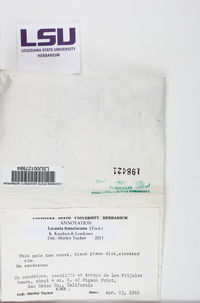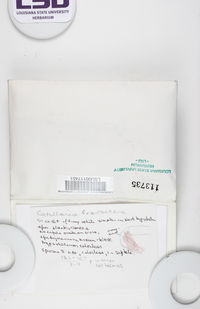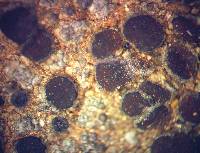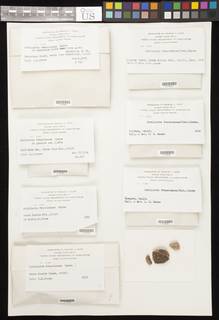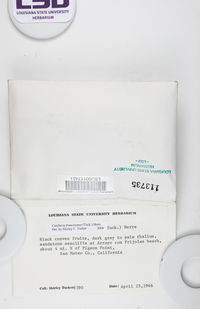
Consortium of Lichen Herbaria
- building a Global Consortium of Bryophytes and Lichens as keystones of cryptobiotic communities -
- Home
- Search
- Images
- Species Checklists
- US States: O-Z >
- US National Parks
- Central America
- South America
- US National Parks
- Southern Subpolar Region
|
Lecania franciscana (Tuck.) K. Knudsen & Lendemer
 (redirected from: Catillaria franciscana (Tuck.) Herre) (redirected from: Catillaria franciscana (Tuck.) Herre) |
|
|
Family: Ramalinaceae
[Biatora franciscana Tuck., moreCatillaria franciscana (Tuck.) Herre] |
Nash, T.H., Ryan, B.D., Gries, C., Bungartz, F., (eds.) 2007. Lichen Flora of the Greater Sonoran Desert Region. Vol 3. Thallus: crustose, effuse, becoming warty to areolate, often crumbling, thick; prothallus: indistinct or absent areoles: numerous and crowded to scattered and few or nearly disappearing, when well developed becoming almost sublobate, 0.5-1.7 mm in diam., thick (up to 0.3 mm) surface: pale brown or beige (darker when wet), paler at margin, esorediate cortex: not investigated photobiont: not investigated Apothecia: sessile with varying degrees of constriction, 0.5-1(-1.7) mm in diam. disc: dull dark brown to black (brown when wet), flat to strongly convex, epruinose; margin: dull black or at first somewhat paler than disc, rather stout, soon disappearing exciple: dull black, soon disintegrating epihymenium: brown to reddish brown, K- hymenium: hyaline, I+ blue, soon wine red, (48-)60-75(-80) µm tall; paraphyses: conherent but separate; not septate; tips thickened (3.5-5(-6.5) µm wide, light brown or gray; hypothecium: hyaline or faintly colored asci: elongate-clavate, Bacidia-type, c. 40 x 10-12 µm, about as high as the paraphyses ascospores: hyaline, 1-septate, oblong, (11.5-)14-21(-25) x 3.5-5(-6.5) µm Pycnidia: not observed Spot tests: thallus K-, C-, P-; medulla I- Secondary metabolites: not investigated. Substrate and ecology: on argillaceous soil and rocks along the coast World distribution: western North America (California) Sonoran distribution: southern California (Channel Islands and adjacent mainland). Notes: Catillaria franciscana is characterized by its areolate thallus and the rather long ascospores. The pale, scarcely thickened paraphysis tips distinguish it from the core group of Catillaria. The description is primarily based on two Hasse collections and additional material from Bratt, Knudsen and Weber. |
Powered by Symbiota




